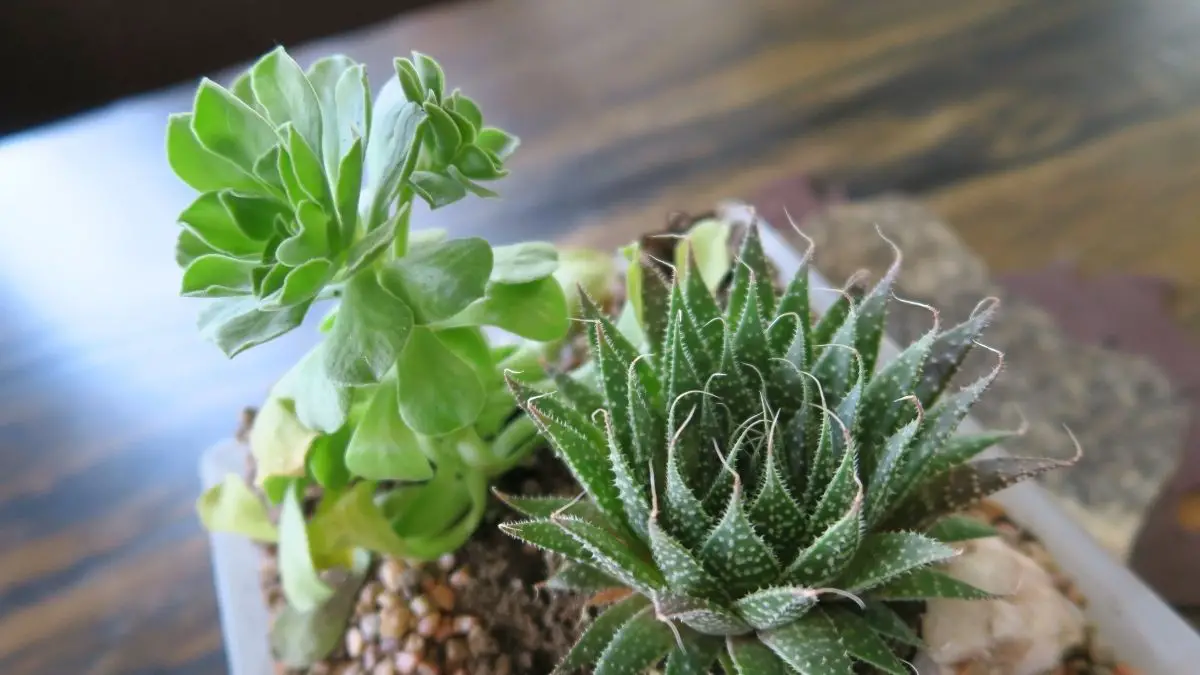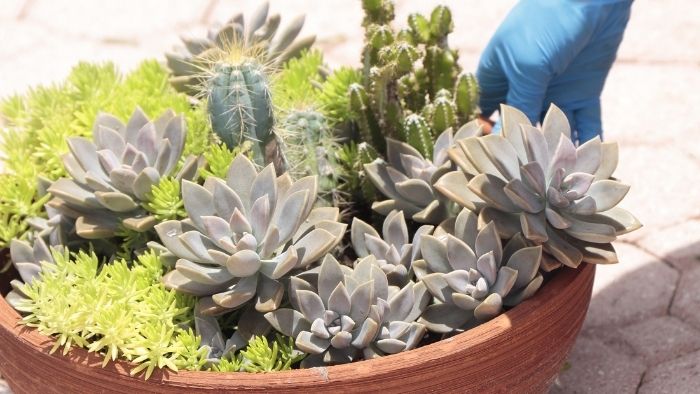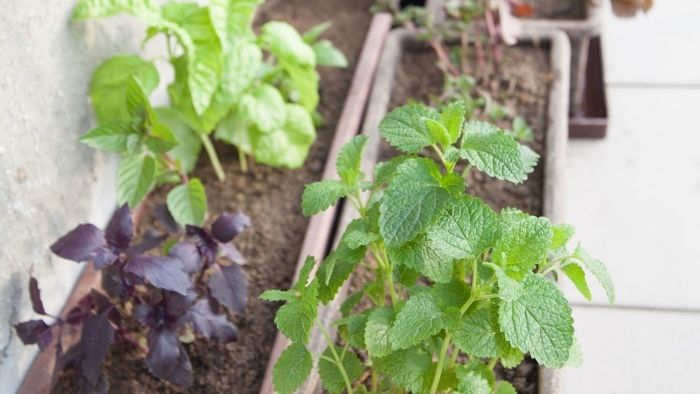Last Updated on July 8, 2022 by Marco C.
In nature we rarely see just one plant species being dominant – in any mature ecosystem, we find that it is composed of a number of plants that all coexist together. Often this coexistence is mutually beneficial. When combining two plants in one pot we can create a system where, if we choose the right plants, they benefit each other! I also find that mixed pots just look better.
What Are The Benefits Of Combining Two Plants In One Pot?
Shelter
Some plants need a bigger plant to protect and shelter them. This is sometimes called a nurse plant – plants such as avocadoes benefit from having a nurse plant to grow next to and provide some shade and support and protection. The nurse plant has a more established root structure, and this can also help protect a more sensitive plant.
When I grow avocado trees in pots I have learned that planting a companion pant such as red amaranth helps the success of the avocadoes. The Amaranth provides shade and shelter, and also helps to regulate soil water – if there is heavy rain, this plant quickly dries the soil protecting the avocadoes fungus prone roots.
Ground Cover
There are many places where having two or more plants in a pot can help various plants meet their needs for protection from harsh sunlight, maintenance of a microclimate, and root health. One of my favorite potted plants is my curry leaf tree – it is a dwarf curry leaf plant in a small pot and below that, I have a layer of hen and chickens as a ground cover. The ground cover helps to keep the soil shaded and vibrant.
This is a winter picture of my curry leaf with hen and chickens growing below it. In summer this plant really thrives – it gets a bit sad in winter. But the combination of the curry plant as the vertical plant, and the hen and chickens as the ground cover works beautifully.
Aesthetics
There is something beautiful about a pot garden with various different leaf colors and structures present. With many plants such as bulbs and succulents, you can create incredibly beautiful mixed pot planting by combining two plants in one pot. You can even plant more than two plants in one pot if you are feeling adventurous! Many succulent species are quite happy to coexist and you can create a rockery in the pot with cacti and stones and highlight the different leaf structures and stem shapes.
Learn more about: The Chart Types Of Succulents – How To Choose The Best Succulents?
Productivity
I once visited a guy in Slovakia who had a garden on his balcony. He had potted maize plants with runner beans growing on them. This method of planting is common in small-scale field agriculture because the maize grows and produces a support structure and the bean grows at the base of the maize plant using it as a trellis. The nitrogen-fixing activity in the roots of the beans helps the maize plant nutritionally.
In the potted environment on a balcony where space is a major limiter to overall production, you need to achieve the highest unit productivity per unit space. His setup with beans and maize in pots was extremely productive because the beans and maize complement each other’s needs.
Succession Planting
In nature, we often find that if a catastrophe happens and a piece of land ends up clear of vegetation that a succession of plants will move in and recover the soil. This starts with pioneer plants that are weed-like, and gradually over the years more and more complex webs of plants develop. As an ecosystem becomes more complex, the relationship between species increases.
An example here would be to compare a piece of land in the Amazon basin. On one piece of the land has rain forest, and on the other, it has been cleared and planted with beef pasture grass. The complexity of the rainforest is greater. If you leave the grassland untended, with time scraggy trees will move in. With more time, more complex trees will move in, and some of these may support ferns and orchids on their branches. Gradually the system gets more complex.
Aesthetic Ecosystem Pot Plant With Gradual Succession
To mimic this, we can often look at a specific ecosystem, and try and recreate a bit of that in our home environment. An example would be to look at the jade plant as a cornerstone plant of our pot planting. Then we would ask, what other common potted plants grow in the natural ecosystem from which the jade plant comes? The answer would be aloes and snake plants. These will all form a happy relationship and with time you may find that one will become more dominant than the other. Our job as custodians of this little ecosystem is to decide if we want a succession where the jade plant crowds the other two out, or do we “maintain” the equilibrium by “browsing” the jade plant so that the aloe and snake plant can get a bit of light too?
Food Succession Planting In A Pot
I have over the years tinkered with growing various herbs in pots – herbs tend to start off quite slowly, and they actually benefit in many cases from having a little cover crop to create a microclimate while they get established. In this case, we are dealing with a short transition.
I believe in radishes as a basic pioneer plant to get a small pot started. Radishes come up in a few days, and in weeks they are ready to harvest. They produce abundant leaf cover, and this can shelter and shade more sensitive plants that need some help to get established.
I normally plant a few radishes and then my “target” plant, such as carrots, oregano, winter or summer savory, basilic, etc.
After a few weeks you will have harvested all of your radishes and the herbs or other plants that were planted underneath will then be ready to harden off in direct sunlight. Herbs tend to have very small leaves, so the seedlings are very small and need a nurse plant above them to shade them a bit while they get established. Once established, most herbs are really tough.
I hope this article has helped you understand the benefits of combining two plants in one pot and how you can mimic nature using this system. You can really increase overall productivity in your growing spaces with these techniques. If you enjoyed it, please share.
Read more about: Growing Multiple House Plants In One Pot
FAQs
Can you combine two plants in the same pot?
You can!! This is actually often far better than having just one plant in a pot as you can plant plants together for mutual benefit. As an example, if it is a food plant pot, and it is on your balcony you may wish to plant a maize plant and a bean. You would need to do this in a few pots to ensure the maize gets pollinated. But you would then get some corn on the cob, and beans growing on the maize plant as an impromptu trellis. The beans provide nutrients to the maize, and the maize provides shelter and support to the bean.
What plants can you put together in a pot?
There are many many plants that are mutually compatible. Cacti of various species and other succulents such as aloes make lovely mixed pot plantings. You can also plant big plants such as ficus that grow up, and plant a ground cover around their roots.
How do you plant multiple plants in one pot?,
If you choose plants that are compatible (similar water requirements/ soil type requirements) and then arrange them so that they do not crowd each other, you can easily set up a two or more plant in a pot system. Naturally choose a pot big enough to allow a bit of growth.
How many plants can you put in one pot?
This will depend on what plants, and the size of your pot! There is no reason why you cannot have many plants in one pot as long as you make sure that the plants basic needs are compatible. If you plant a cactus that likes mainly dry soil in the same pot as a lilly that likes moist soil you may suffer a disappointment. If you however plant five cacti in one pot, or 5 lillies in one pot, you will avoid dissapointment.
Dr. Garth A. Cambray is a Canadian/South African entrepreneur and beekeeper with 28 years of experience in apiculture and specializes in adding value to honey. His Ph.D. research developed a new advanced continuous fermentation method for making mead that has resulted in a number of companies globally being able to access markets for mead. His company, Makana Meadery, exports honey mead to the USA where it is available to discerning connoisseurs. He has also developed technologies to commercially manufacture organic honey vinegar in Zambia for export globally. He holds a few patents globally in the ethanol industry and believes in technology and knowledge transfer for human development and environmental sustainability. One of his proudest achievements is the fact that the wind farm he started at one of his old apiary sites has essentially made his hometown carbon neutral.




